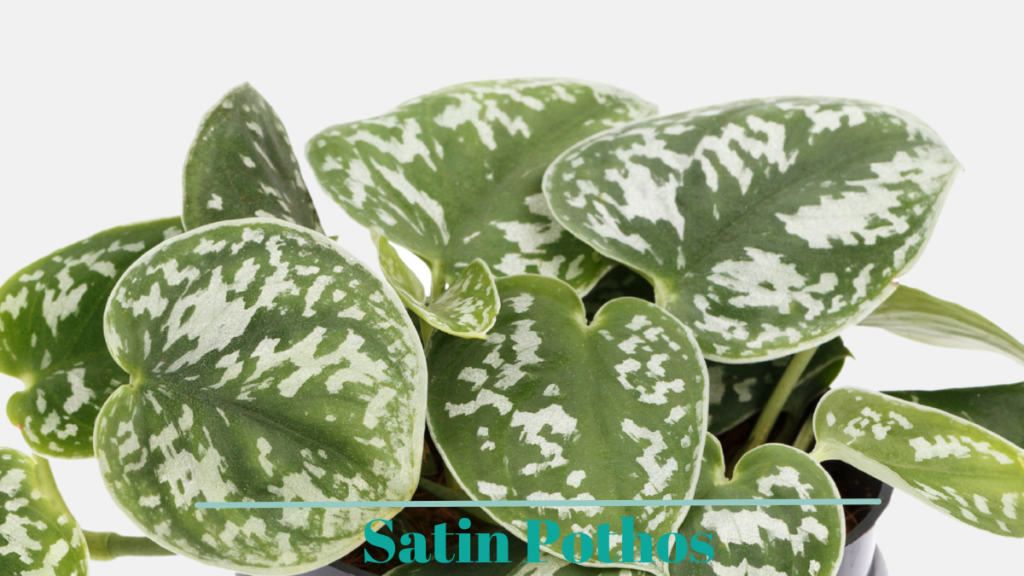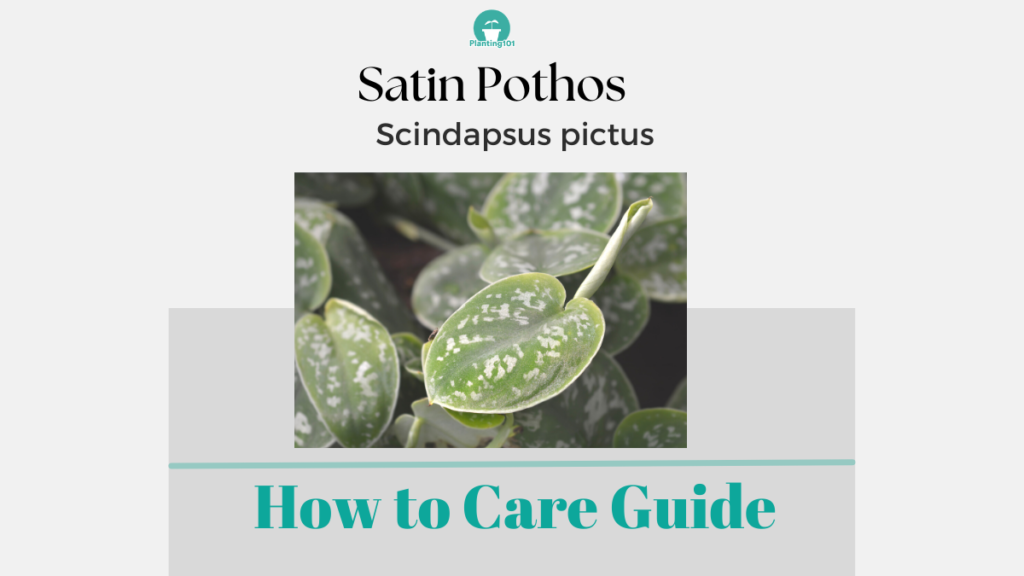Satin Pothos (Scindapsus pictus) is an easy-to-grow indoor plant. It has beautiful silvery, green leaves that will look great in a hanging basket or perched on a bookshelf. Similar to other Pothos houseplants, your Satin Pothos is toxic to pets and humans so keep it away from pets and children. Here is a beginner’s guide on how to care for your Satin Pothos.

Satin Pothos Houseplant Care at a Glance
| Name | Satin Pothos |
| Scientific Name | Scindapsus pictus |
| Care Level | Easy |
| Light | Bright Indirect Light. Can Tolerate Medium Light. |
| Daytime Temperature | 70 to 80 F (21-26C) |
| Night Time Temperature | 60 to 70 F (15-21C) |
| Water | Moderate Water |
| Humidity | High Humidity |
| Potting | Well-draining, organic, all-purpose potting mix |
| Fertilizer | Once a month during the growing season |
| Toxic to Pets and Humans | Toxic |
Satin Pothos: Common Names
Satin Pothos is also called silk pothos and, satin potho.
Satin Pothos: Size
The stem of your Satin Pothos can grow quite long, easily to 4-10 feet long if you let it.
Satin Pothos: Toxic to Dogs?
Satin Pothos are toxic to dogs (source: ASPCA). Don’t let your dog chew on the leaves of the Satin Pothos plant because it contains calcium oxalate crystals. The crystals can cause vomiting and difficulty breathing. It can also result in swelling of lips, tongue, and mouth and excessive drooling. Keep it out of reach from your dog!
Satin Pothos: Toxic to Cats?
Satin Pothos are toxic to cats (source: ASPCA). Keep it away from your cat because it contains calcium oxalate crystals. The crystals can cause vomiting and difficulty breathing. It can also result in swelling of lips, tongue, and mouth and excessive drooling.
Satin Pothos: Toxic to Humans?ASPCA
Satin Pothos are toxic to humans. Keep it in a hanging basket or high up on a bookshelf so it is away from small children. Teach older children the danger of Satin Pothos. Don’t let children chew on the leaves of the Satin Pothos plant because it contains calcium oxalate crystals. The crystals can cause vomiting and difficulty breathing. It can also result in swelling of lips, tongue, and mouth and excessive drooling. I
f you see any of these symptoms and suspect ingestion of Satin Pothos plants, call poison control immediately! Also, call your doctor once you start seeing adverse reactions in children.
Light
Satin Pothos: Sun or Shade?
Satin Pothos will be happy in a bright, indirect light location. It can also tolerate medium-light conditions.
Water
How Often Should You Water Your Satin Pothos?
Your Satin Pothos has moderate water requirements. Water your Satin Pothos when the soil feels dry. The best way to tell when it is time to water your Satin Pothos is to feel the soil. Stick your finger in the soil 1 inch deep. If it feels dry, it’s time to water your Satin Pothos.
What Type of Water Should You Use When Watering Your Satin Pothos?
Your Satin Pothos can be watered with tap water but be mindful of the water temperature that you are using to water your Satin Pothos. Don’t use straight cold water from the tap to water your Satin Pothos.
Satin Pothos prefers cool water that is not hot and not cold. When you turn on the cold water from the faucet add a little bit of warm water. You can also get to this ideal temperature by filling a watering can or pitcher with water and leaving it out overnight until the water is at room temperature.
How Do You Make Sure There is Proper Drainage for Your Satin Pothos?
Your Satin Pothos Good drainage is important, you don’t want your Satin Pothos to sit in soggy soil. Make sure there are drainage holes at the bottom of the pot. After watering your Satin Pothos and you see water draining out of the pot’s drainage holes, make sure you empty out the accumulated water in the saucer. Don’t let your Satin Pothos’s pot sit in this puddle of water. It will cause root rot!
Do You Need to Mist Your Satin Pothos?
Your Satin Pothos is a tropical houseplant that likes humid conditions. You should increase indoor humidity. Turn on the humidifier. Don’t mist your Satin Pothos though because water can get on the roots and that will result in overwatering.
Soil
What Type of Potting Mix is Best for Your Satin Pothos?
Your Satin Pothos needs a well-draining, organic all-purpose potting mix.
How Do You Know When To Repot Your Satin Pothos?
Repot your Satin Pothos every 2 years or when you start seeing the roots come out of the drainage holes. Repot your Satin Pothos in a container with a diameter 2 inches larger than the current pot.
Fertilizer
Do You Need to Fertilize Your Satin Pothos?
Your Satin Pothos should be fertilized once a month during the growing season.
What Fertilizer Should You Use on Your Satin Pothos?
Use liquid or powder, organic fertilizer on your Satin Pothos.
Propagation
How Do You Propagate Your Satin Pothos?
Your Satin Pothos Satin Pothos Plant is easy to propagate. You can propagate your Satin Pothos plant by leaf cutting. Below are steps on how to propagate Satin Pothos Plant by leaf cutting.
1. Take a Leaf Cutting of your Satin Pothos Plant
Cut a mid-sized leaf from your Satin Pothos and include 1-2 inches of the leaf stalk.
2. Plant Your Satin Pothos Leaf
Dip the leaf stalk into the rooting hormone and then plant it into a pot. Make sure the soil mixture is damp by watering it thoroughly before planting the leaf stalk. You can plant more than one leaf in the pot.
3. Repot Your Satin Pothos to its Permanent pot
The roots of your Satin Pothos will grow in 2-4 weeks. You will see the baby leaves will be about 1 inch long. When that happens, you can repot your Satin Pothos to its permanent container.
4. Place New Satin Pothos Plant in a Spot with Bright Indirect Sun
Place your new Satin Pothos plant in a spot with bright indirect sunlight. Don’t put it in direct sunlight.
Common Problems of Satin Pothos Care
The most common problems that affect Satin Pothos are scale and spider mites.
Satin Pothos Problem: Yellow and Brown Spots with Spider-Like Webs the on Leaves and Stems of your Satin Pothos
Problem: There are yellow and brown spots on the leaves of your Satin Pothos. You also see spider web-like webbing on the leaves and stems.
Cause: The spider webbing and yellow and brown spots are signs of spider mites attacking your Satin Pothos. Spider mites are tiny pests that are too small to see with your bare eyes. Solution: To treat spider mites on your Satin Pothos, spray off the leaves with water from a garden hose. The force will cause the little spider mites to wash off the leaves. You can also wash mites off with soapy water or rubbing alcohol. There are also horticultural oils and insecticidal soaps that you can use to kill off spider mites.
Check out our article on how to make your own homemade pesticides using baby shampoo: How to Make Horticultural Oil and How to Make Insecticidal Soap
Satin Pothos Problem: Many Small Brown Bumps on Leaves of your Satin Pothos
Problem: If you see little brown bumps all over the leaves and stems of your Satin Pothos, that can be a sign of scale. Try picking the bumps off, if it’s easily removed then that’s a telltale sign of scale. The little bumps can also be gray, yellow, or black.
Cause: Scale is common on houseplants and is caused by scale insects.
Solution: You can get rid of scale by picking them off one by one. Or the easier way to get rid of scale is to spray your Satin Pothos with insecticidal soap or horticultural oil.
Cleaning Satin Pothos Houseplant
What’s the best way to clean the leaves of your Satin Pothos?
Dust accumulates on your Satin Pothos leaves over time. The layer of dust decreases the plant’s ability to photosynthesize. Periodically wiping down the leaves of your Satin Pothos with a damp cloth will help keep your plant healthy. You can also use a duster or dry duster cloth to wipe off the layer of dust on leaves.
You May Also Be interested in these Hanging Houseplants
How to Care for your Pothos (Epipremnum aureum)
How to Care for your Satin Pothos
How to Care for your Heartleaf Philodendron
How to Care for Your String of Pearls Plant
How to Take Care of Your Boston Fern (Nephrolepsis exaltata)

